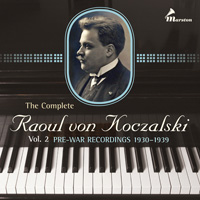A Note From Ward Marston
This second volume of Raoul von Koczalski’s pre-war recordings is divided into three sections by record company: Homocord, Electrola, and Deutsche Grammophon. Little is known about the Homocord recordings and it is impossible to date them accurately because there is no extant documentation for the actual recording sessions. Because Homocord was a German company, the Koczalski recordings were presumed to have been recorded in Berlin. Recently, however, Christian Zwarg, a major authority on the dating of undocumented recordings, has researched the Homocord matrix system and has determined that these Koczalski recordings are part of a series recorded in Milan in September of 1930. We have not been able to determine whether all of these recordings were issued by Homocord before the company became a part of the Lindström group, but several sides were issued in 1936 and 1937 on the Odeon label after Lindström had acquired the defunct Homocord catalog.
Koczalski’s Deutsche Grammophon recordings present a similar difficulty because the recording session logs have not survived. Fortunately the exhaustive research of Michael Gray has uncovered documentation of the dates when the wax masters were received by the factory in Hannover for processing and pressing. In fact, we do know the precise recording dates of some recordings from this period as well as the dates when the waxes were received at the factory. Using the evidence of such recordings, it appears that the wax masters usually arrived at the factory three days after they were recorded. Therefore, we can deduce the date of recording by subtracting three days from the date when each group of masters was received at the factory. While on the subject of the DGG recordings, it should be pointed out that when Koczalski recorded Chopin’s etudes, he had to play them out of sequence in order to squeeze them on to the minimum number of 78 rpm sides: six sides for Op. 10, seven for Op. 25, and one for the three Nouvelle Etudes. We have reordered the etudes to reflect Chopin’s sequence. His recording of the twenty-four preludes, Op. 28, were made in proper sequence on successive matrix numbers.
© Ward Marston, 2015

The Complete Raoul von Koczalski vol. 2
Homochord, Electrola, and Polydor recordings, 1930-1939
Raoul von Koczalski was born in 1885 and at the age of seven began studying with Chopin-student Karol Mikuli. The first impression of Koczalski’s playing is often one of the fluency and grace of his execution, coupled with his subtlety of phrasing and smooth legato, but what one is often left with is his use of rubato. This aspect of his playing has given rise to debate about Chopin’s musical intentions and has sparked both criticism and admiration of Koczalski’s playing; it will delight many and dissuade some, while asking all to consider if this is the definitive interpretation of Chopin. This three CD-set is the second and final volume of the complete pre-war recordings of this controversial pianist. It is almost entirely devoted to Chopin, including recordings of the complete etudes, preludes, and ballades.